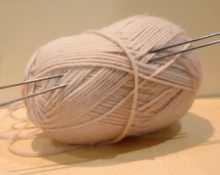Among knitting needlewomen, there are not many who can independently come up with a model and pattern for a future item. Most people get ideas from fashion magazines. The most convenient option is the one that includes a detailed description (perhaps even without reference to the pattern). In other words, step-by-step guidance is welcome: how many stitches to cast on, how many rows and what pattern to knit. But it happens that the model you like turns out to be small or large.
How to “adjust” a knitting pattern to your parameters
First of all, you need to determine how much the model is smaller or larger than the one you need. All further actions depend on this.
Determining the density of the future product
The description of the diagrams usually states:
- type of thread, its composition and thickness, as well as the required thickness of the knitting needles;
- knitting density (number of loops per 10 cm of finished fabric in width and number of rows per 10 cm in height).
However, compliance with even the given size can be quite conditional, namely:
- the recommended yarn will be thicker or thinner than the one that is available (for example, it has already been purchased and the craftswoman wants to knit an item from it);
- The knitting density may not coincide with the specified one, since it is determined not only by the thickness of the threads, but also by the individual knitting style (tight or loose).
By the way! Some yarns, such as wool, tend to stretch or shrink after washing. To avoid ending up with a dress with knee-length sleeves instead of a jumper, it is advisable to soak the yarn in water at a maximum but acceptable temperature and then dry it. This must be done before starting knitting.
Once the yarn is ready to work, you can start measuring. You need to cast on the number of loops that corresponds to 10 cm according to the instructions, knit with the proposed pattern, and then measure the width of the resulting sample. If the result matches the description, choose your size. If there are discrepancies or the required size is not available at all, you will have to navigate along the way, based on your own dimensions.
Calculations and adjustments to the drawing
Firstly, the width of the product can be calculated independently. Let's say you are knitting a skirt on circular knitting needles. In this case, the volume of your hips is 96 cm, and the knitting density is 24 p * 10 cm.
Important! You'll have to remember the proportion formula from your school math course. In our case, the calculations will be as follows:
24 p. – 10 cm;
x p. – 96 cm;
x = (24 p. * 96 cm): 10 cm = 230 p. with a tail. The tail can be ignored for now.
Next, we determine the number of rapports. If the pattern motif is not wide, such as 1*1 or English elastic - 2 loops, there is nothing to worry about.The main thing here is that the total number of stitches cast on is even. In other cases it should be a multiple of the number of loops in one motif.

Let's say you liked a pattern with a repeat of 6 loops. We divide our 230 by 6 and get a surprise in the form of a remainder. There are two ways out of this situation:
- Instead of 230, dial 228 (for 38 rapports) and not get better.
- Increase the total number of loops when casting on to 234 (4 loops will not play a big role).
If the motif is more voluminous, it may be more difficult to “fit” into the size. Here you can consider options for inserting front or back loops between repeats or along the edges of the product (in a jumper, vest). The main thing is that the overall design does not suffer, but looks natural, as if it was intended that way.
Knitting is a painstaking job that requires concentration, time and precision. In order not to unravel the knitted one several times, you need to correctly calculate the number of loops for casting on, and if necessary, increase or decrease the number of repetitions of the pattern. If any changes are made to the original description, it is better to link a small sample transition to see what happens in the end, and be calm about the final result.


 1
1





